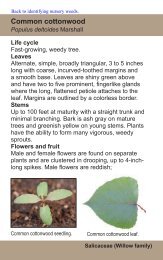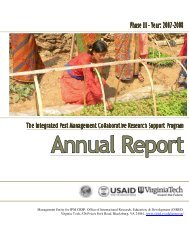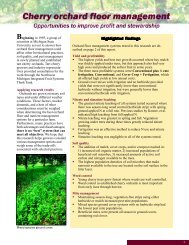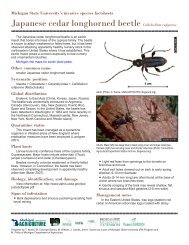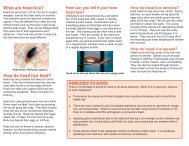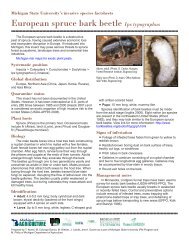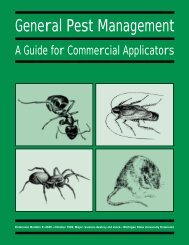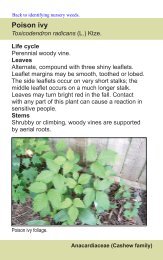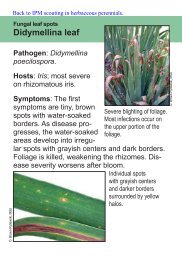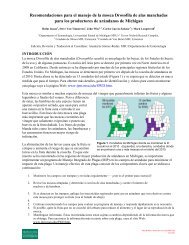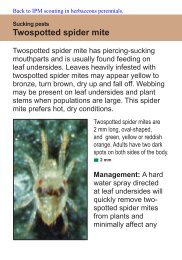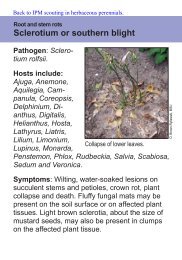Whole Manual - Michigan State University: Integrated Pest ...
Whole Manual - Michigan State University: Integrated Pest ...
Whole Manual - Michigan State University: Integrated Pest ...
You also want an ePaper? Increase the reach of your titles
YUMPU automatically turns print PDFs into web optimized ePapers that Google loves.
Outbreaks occur first as isolated patches but quickly<br />
spread throughout the rest of the field. Favorable conditions<br />
such as overhead irrigation and rainy, windy<br />
weather increase the rate of spread of Alternaria.<br />
Aster yellows stunts and discolors foliage.<br />
Control strategies:<br />
■ Control leafhopper populations to prevent disease<br />
transmission.<br />
■ Control weeds. Weed and grass hosts near the target<br />
crop can harbor aster yellows and leafhopper eggs.<br />
■ Plant tolerant/resistant carrot varieties.<br />
■ Plant early to establish the crop prior to possible infection.<br />
■ Remove infected plants, if feasible, to prevent the<br />
spread of an existing infection.<br />
Control strategies:<br />
■ Postharvest tilling helps reduce the overwintering<br />
inoculum. Turning under carrot residue will accelerate<br />
decomposition.<br />
■ Avoid continuous carrot cropping. Growers in<br />
<strong>Michigan</strong> frequently rotate a minimum of two years,<br />
but this does not seem to deter the disease.<br />
■ Do not plant new fields near infested fields.<br />
■ Use clean seed and resistant cultivars.<br />
■ Regular fungicide applications control Alternaria leaf<br />
spot.<br />
CERCOSPORA LEAF SPOT<br />
ALTERNARIA LEAF SPOT<br />
Leaves with lesions in a Cercospora infected carrot plant.<br />
Pathogen type: fungus (Cercospora carotae)<br />
Carrots infected with Alternaria.<br />
Pathogen type: fungus (Alternaria dauci)<br />
Disease symptoms: Dark brown/black spots with yellow<br />
margins appear on older leaves. The leaves may begin to<br />
curl at the edges as the plant matures. This can result in<br />
weak foliage or defoliation and make harvest impossible.<br />
The disease can also cause damping-off of seedlings and<br />
often occurs concurrent with Cercospora leaf spot.<br />
Environmental conditions favoring disease: Alternaria<br />
fungus overwinters in soil and plant debris and in volunteer<br />
carrots. Pathogens are blown by the wind, carried<br />
by water or equipment, or introduced within the seed.<br />
Disease symptoms: The first symptoms are circular spots<br />
about 1/16 to 1/8 inch in diameter on both leaves and petioles.<br />
Spots resemble a target with a tan center, a dark<br />
brown ring, and an outer yellow ring, which will be inconspicuous<br />
on some plants. As the fungus grows, lesions<br />
encircle petioles, causing defoliation. Plants show symptoms<br />
as soon as three days after infection. Cercospora<br />
often occurs concurrent with Alternaria leaf spot.<br />
Environmental conditions favoring disease: Cercospora<br />
produces spores during warm, humid weather. The<br />
spores are transported primarily by wind. Healthy carrot<br />
tissue can be infected when leaves remain wet for eight or<br />
more hours. The fungus can survive in seed, in carrot<br />
debris in soil, or in wild carrot.<br />
Control strategies:<br />
■ Plant disease-free seed and disease-tolerant cultivars.<br />
■ Practice a two-year crop rotation and plow under carrot<br />
residue to decompose (the fungus dies after the<br />
debris decomposes).<br />
■ Chemical controls can be applied.<br />
Chapter 7<br />
62<br />
Vegetable Crop <strong>Pest</strong> Management



